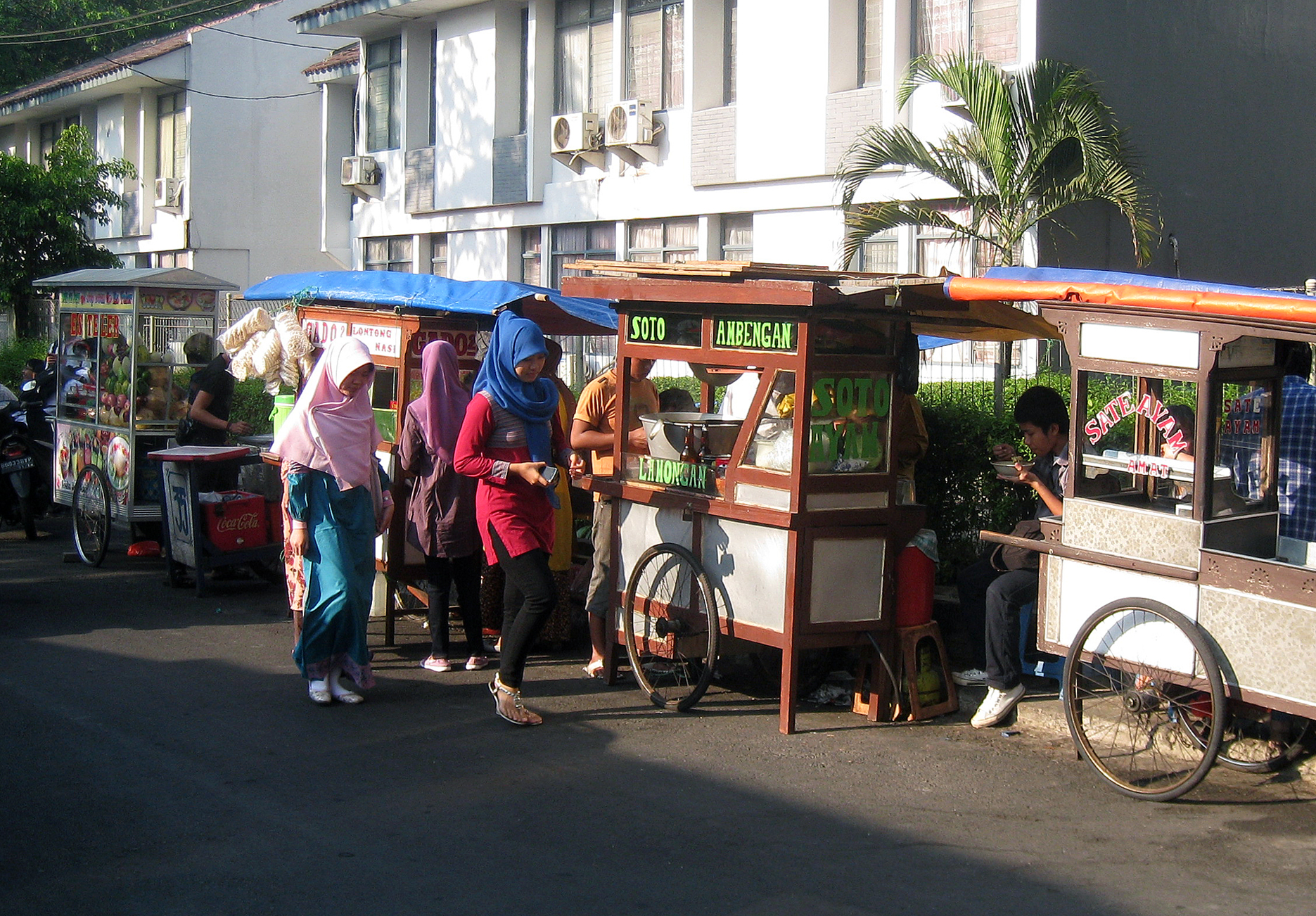|
Street Food Of Indonesia
Indonesian street food is a collection of ready-to-eat meals, snacks, fruits and drinks sold by hawkers or vendors at ''warung'' food stalls or food carts. Street food in Indonesia is a diverse mix of local Indonesian, Chinese, and Dutch influences. Indonesian street food are usually cheap, offer a great variety of food of different tastes, and can be found on every corner of the city. Most Indonesian street food is affordable, with prices usually less than a US dollar (13,150.80 rupiah). However, there are also some street foods that are priced more than 20,000 rupiah (1.52 US dollar). Indonesian street food often colloquially called as ''kaki lima'' (Indonesian for "five-feet") or ''jajanan kaki lima'' ("five-feet buys"), which refer to five foot way pedestrian pavements along the street that often occupied by street hawkers selling food. In 2015, the Cooperatives, Micro, Small and Medium Enterprises and Trade Agency recorded that Jakarta has around 56,000 street vendors a ... [...More Info...] [...Related Items...] OR: [Wikipedia] [Google] [Baidu] |
Jakarta Indonesia Hawkers-in-Kota-Jakarta-01
Jakarta (; , bew, Jakarte), officially the Special Capital Region of Jakarta ( id, Daerah Khusus Ibukota Jakarta) is the capital and largest city of Indonesia. Lying on the northwest coast of Java, the world's most populous island, Jakarta is the largest city in Southeast Asia and serves as the diplomatic capital of ASEAN. The city is the economic, cultural, and political centre of Indonesia. It possesses a province-level status and has a population of 10,609,681 as of mid 2021.Badan Pusat Statistik, Jakarta, 2022. Although Jakarta extends over only , and thus has the smallest area of any Indonesian province, its metropolitan area covers , which includes the satellite cities Bogor, Depok, Tangerang, South Tangerang, and Bekasi, and has an estimated population of 35 million , making it the largest urban area in Indonesia and the second-largest in the world (after Tokyo). Jakarta ranks first among the Indonesian provinces in human development index. Jakarta's busin ... [...More Info...] [...Related Items...] OR: [Wikipedia] [Google] [Baidu] |
Indonesian Travelling Meatball Vendor On Bike
Indonesian is anything of, from, or related to Indonesia, an archipelagic country in Southeast Asia. It may refer to: * Indonesians, citizens of Indonesia ** Native Indonesians, diverse groups of local inhabitants of the archipelago ** Indonesian women, overview of women's history and contemporary situations * Indonesian language (Indonesian: ''Bahasa Indonesia''), the official language of Indonesia ** Indonesian languages, overview of some of the 700 languages spoken in Indonesia ** Indonesian names, customs reflecting the multicultural and polyglot nature of Indonesia * Indonesian culture, a complex of indigenous customs and foreign influences ** Indonesian art, various artistic expressions and artworks in the archipelago ** Indonesian cinema, a struggling and developing industry ** Indonesian literature, literature from Indonesia and Southeast Asia with shared language roots ** Indonesian music, hundreds of forms of traditional and contemporary music ** Indonesian philosoph ... [...More Info...] [...Related Items...] OR: [Wikipedia] [Google] [Baidu] |
Deep Frying
Deep frying (also referred to as deep fat frying) is a cooking method in which food is submerged in hot fat, traditionally lard but today most commonly oil, as opposed to the shallow oil used in conventional frying done in a frying pan. Normally, a deep fryer or chip pan is used for this; industrially, a pressure fryer or vacuum fryer may be used. Deep frying may also be performed using oil that is heated in a pot. Deep frying is classified as a hot-fat cooking method. Typically, deep frying foods cook quickly: all sides of the food are cooked simultaneously as oil has a high rate of heat conduction. The term "deep frying" and many modern deep-fried foods were not invented until the 19th century, but the practice has been around for millennia. Early records and cookbooks suggest that the practice began in certain European countries before other countries adopted the practice. Deep frying is popular worldwide, with deep-fried foods accounting for a large portion of glob ... [...More Info...] [...Related Items...] OR: [Wikipedia] [Google] [Baidu] |
Gado-gado
''Gado-gado'' (Indonesian or Betawi) is an Indonesian salad of raw, slightly boiled, blanched or steamed vegetables and hard-boiled eggs, boiled potato, fried tofu and tempeh, and ''lontong'' (rice wrapped in a banana leaf), served with a peanut sauce dressing. In 2018, ''gado-gado'' was promoted as one of five national dishes of Indonesia; the others are soto, sate, nasi goreng, and rendang. Etymology The term ''gado'' or the verb ''menggado'' means to consume something without rice. ''Gado-gado'' in Indonesian literally means "mix-mix" since it is made of a rich mixture of vegetables such as potatoes, longbeans, bean sprouts, spinach, chayote, bitter gourd, corn and cabbage, with tofu, tempeh and hard-boiled eggs, all mixed in peanut sauce dressing, sometimes also topped with '' krupuk'' and sprinkles of fried shallots. ''Gado-gado'' is different from ''lotek atah'' or '' karedok'' which uses raw vegetables. Another similar dish is the Javanese '' pecel''. Reg ... [...More Info...] [...Related Items...] OR: [Wikipedia] [Google] [Baidu] |
Ketoprak (food)
''Ketoprak'' is a vegetarian dish from Jakarta, Indonesia, consisting of tofu, vegetables, rice cake, and rice vermicelli served in peanut sauce. Etymology and origin The etymology of the name ''ketoprak'' is unknown, and its name similarity to the Javanese folk-drama is peculiar. However, according to popular Betawi tradition, ''ketoprak'' was actually derived from the acronym of its ingredients; which are ''ket'' from ''ketupat'', ''to'' from '' tahu'' and '' toge'', and ''prak'' from ''digeprak'' ( Betawi for: "mashed" or "crushed"), which describes the method on grounding garlic, chili pepper and peanut granules together to create the peanut sauce. It is also believed that a man who loved eating invented the dish because he grew tiresome of the food he had normally eaten. When he dropped the dish on to the floor, the plate made the sound "''ketuprak''", which is where he got the idea for the name. In addition to its unique name, ketoprak is also unique in that all the s ... [...More Info...] [...Related Items...] OR: [Wikipedia] [Google] [Baidu] |
Asinan
''Asinan'' is a pickled (through brined or vinegared) vegetable or fruit dish, commonly found in Indonesia. ''Asin'', Indonesian for "salty", is the process of preserving the ingredients by soaking them in a solution of salty water. ''Asinan'' is quite similar to ''rujak', which is usually served fresh, while ''asinan'' is preserved vegetables or fruits. Of the many types and variations of ''asinan'' in Indonesia, the most popular are ''asinan Betawi'' and ''asinan Bogor''. Asinan can be found served in restaurant, ''warung'' and also travelling street vendor. * ''Asinan Betawi'': The vegetable ''asinan'' of the Betawi people from Jakarta is preserved Chinese cabbage, cabbage, bean sprouts, tofu, and lettuce served in a thin, hot, peanut sauce with vinegar, topped with peanuts and ''krupuk'' (especially ''krupuk mie''). * ''Asinan Bogor'': The fruit ''asinan'' of Bogor city, West Java is preserved tropical fruits, such as raw mango, water apple, papaya, ambarella, jicama, n ... [...More Info...] [...Related Items...] OR: [Wikipedia] [Google] [Baidu] |
Satay
Satay ( , in USA also , ), or sate in Indonesian spelling, is a Southeast Asian dish of seasoned, skewered and grilled meat, served with a sauce. The earliest preparations of satay is believed to have originated in Javanese cuisine, but has spread to almost anywhere in Indonesia, where it has become a national dish. Indonesian satay is often served with peanut sauce – a sauce made from peanut butter, and is often accompanied with lontong, a type of rice cake, though the diversity of the country has produced a wide variety of satay recipes. It is also popular in many other Southeast Asian countries including Brunei, Malaysia, Philippines, Singapore and Thailand. It is also recognized and popular in Suriname and the Netherlands. In Sri Lanka, it has become a staple of the local diet as a result of the influences from the local Malay community. Satay may consist of diced or sliced chicken, goat, mutton, beef, pork, fish, other meats, or tofu; bamboo skewers are often ... [...More Info...] [...Related Items...] OR: [Wikipedia] [Google] [Baidu] |
Siomay
Siomay (also Somai), is an Indonesian steamed fish dumpling with vegetables served in peanut sauce. It is derived from the Chinese Shumai. It is considered a light meal, similar to the Chinese Dim Sum. It is traditionally made from pork but is frequently substituted with ''tenggiri'' (spanish mackerel), as many Indonesians observe the ''halal'' dietary law. Sometimes other types of seafood such as tuna, mackerel, and prawn also can be used to make siomay. Other complements to siomay include steamed cabbage, potatoes, bitter gourd, boiled egg, and tofu. Siomay is often cut into bite size pieces and topped with peanut sauce, sweet soy sauce, chili sauce and a dash of lime juice. Origin and varieties Siomay is ubiquitous in Indonesian cities, it is one of the most popular snack or light meal in Indonesia. It can be found in street-side food stalls, travelling carts, bicycle vendors, and restaurants, and is considered a popular school meal for Indonesian students. Just like ''bak ... [...More Info...] [...Related Items...] OR: [Wikipedia] [Google] [Baidu] |
Peanut Sauce
Peanut sauce, satay sauce (saté sauce), ''bumbu kacang'', ''sambal kacang'', or ''pecel '' is an Indonesian sauce made from ground roasted or fried peanuts, widely used in Indonesian cuisine and many other dishes throughout the world. Peanut sauce is used with meat and vegetables, adding flavor to grilled skewered meat, such as satays, poured over vegetables as salad dressing such as in '' gado-gado'', or as a dipping sauce. Ingredients The main ingredient is ground roasted peanuts, for which peanut butter can act as a substitute. Several different recipes for making peanut sauces exist, resulting in a variety of flavours, textures and consistency. A typical recipe usually contains ground roasted peanuts or peanut butter (smooth or crunchy), coconut milk, soy sauce, tamarind, galangal, garlic, and spices (such as coriander seed or cumin). Other possible ingredients are chili peppers, sugar, fried onion, and lemongrass. The texture and consistency (thin or thick) of a pea ... [...More Info...] [...Related Items...] OR: [Wikipedia] [Google] [Baidu] |
Rojak
Rujak (Indonesian spelling) or Rojak ( Malay spelling) is a salad dish of Javanese origin, commonly found in Indonesia, Malaysia and Singapore. The most popular variant in all three countries is a salad composed of a mixture of sliced fruit and vegetables served with a spicy palm sugar dressing. It is often described as tangy and spicy fruit salad due to its sweet, hot and spicy dressing made from ground chilli, palm sugar and peanuts. There is a diverse variety of preparations, especially in Indonesian cuisine, and rujak is widely available throughout Indonesia. While the most common variant is primarily composed of fruits and vegetables, its sweet and tangy dressing is often made with prawn paste. Some recipes may contain seafood or meat components, especially in Malaysia and Singapore where a notable variant shows influence from Indian Muslim cuisine. Etymology Rujak is one of the oldest dishes and the earliest historically identified food of ancient Java. The word "ru ... [...More Info...] [...Related Items...] OR: [Wikipedia] [Google] [Baidu] |




